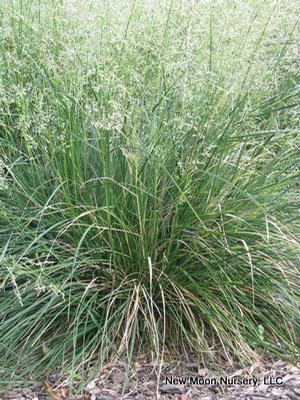Printed at http://www.newmoonnursery.com/index.cfm/
Deschampsia caespitosa
Tufted hairgrass
Native to North America
FIRST IMPRESSIONS: Deschampsia cespitosa is a robust clump forming perennial grass. The tufted foliage is narrow, fine textured and usually evergreen. Airy panicles of purplish green florets with hair like awns form in summer. They mature into a buff color and remain until frost. This cool season grass thrives in shaded or partly sunny moist or wet sites.
HABITAT & HARDINESS: Deschampsia cespitosa occurs in Canada and the United States. Plants are absent from the central United States from Nebraska and Iowa to Texas and Louisiana and are also absent from most of the Southeastern United States.
This species is indigenous to cool damp habitats including estuaries, moist mountain meadows, calcareous wetlands, seeps, floodplain forests, pond and stream margins and marshy grasslands. In the eastern United States, Deschampsia cespitosa is generally found in disturbed soggy fields or roadsides. In western states it occurs in a wide range of montane habitats and is often a dominant species of alpine meadows.
This grass is hardy from USDA Zones 2-8.
PLANT DESCRIPTION: Deschampsia cespitosa is cool season rhizomatous bunchgrass with a mounding habit. Plants form sod like patches with dense deep root systems.
Leaves are linear, arching and evergreen or semi-evergreen. They are borne in dense deep green or blue-green tussocks.
Attractive florets with hair-like awns are displayed above the foliage in loose openly branched panicles. The florets are purplish when young becoming bronze or golden brown with age.
The panicles have a light airy quality. They refract the late afternoon light beautifully even after the florets transition into seed. The flower and fruit display is striking through summer and into autumn.
Plants attain 2-4’ height with 1-2’ spread.
CULTURAL & MAINTENANCE NEEDS: Deschampsia cespitosa prospers in partly shaded sites with moist humus rich soils. This grass will tolerate some sun if moisture is present but in densely shaded locations, it may not flower well.
This species tolerates a variety of moisture regimes including well drained soils and sites with seasonal flooding. Plants endure short periods of drought but not year round flooding.
Plants grow in a wide range of soil types and tolerate alkaline pH and moderate salinity.
In garden situations, old foliage and seed stalks can be cut to the ground in late winter to provide a blank slate for fresh new growth. If undesirable self-seeding occurs, deadheading should be done in autumn to remove seed.
LANDSCAPE USES: Deschampsia cespitosa has delightful airy flower panicles that allow it to serve as a lovely Accent, Grouping or Mass for the Shade Garden. Plants provide Erosion Control and offer Showy Flowers, Attractive Seedheads and Winter Interest. Plants are useful Cut Flowers and are appropriate for Low Maintenance Plantings, Meadow Gardens, Perennial Borders, margins of Water Gardens, Rain Gardens, Rock Gardens and Wildlife Gardens.
COMPANION & UNDERSTUDY PLANTS: Try pairing Deschampsia cespitosa with Carex radiata, Chasmanthium latifolium, Eupatorium coelestinum or Rudbeckia laciniata.
If a substitute is needed, Chasmanthium latifolium has coarser texture but similar height and cultural needs. In gardens situations, the cultivar Deschampsia cespitosa ‘Schottland’ would be a suitable replacement.
TRIVIA: Deschampsia cespitosa provides seed to game birds and songbirds. Grazing animals feed on the foliage along with caterpillars of umber skippers. In wet areas, the mounding growth provides cover to nesting waterfowl and small mammals.
Height:
2-4 ftSpread:
1-2 ftSpacing:
2-3 ftUSDA Hardiness Zone:
2-8Bloom Color:
Green, TanDeschampsia caespitosa Characteristics
Attracts Wildlife
- Songbirds
Attributes
- Ground Cover
- Dried Flower
Exposure
- Partial Shade to Full Sun
Flowering Months
- July
Grass Season
- Cool Season Grass
Juglans nigra Tolerance (Black Walnut)
- Yes
Lawn Replacement or Groundcover
- Groundcover
- Lawn Replacement
Phytoremediation
- Zn-Zinc
- Ni - Nickel
- Cu-Copper
- Mg - Magnesium
- Fe - Iron
Salt Tolerance
- Medium
Season of Interest (Foliage)
- Winter
- Fall
- Summer
- Spring
Soil Moisture Preference
- Moist to Wet
Interesting Notes:
For more information on this plant, visit the USDA PLANTS Database: http://plants.usda.gov/java/profile?symbol=dece

